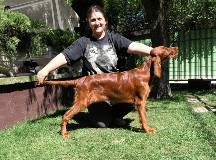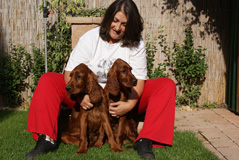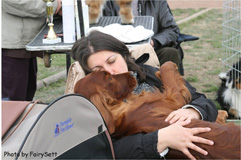From the Irish Setter officially from a well-written writing and from my own experiences:
A little history and official description (from Norbert Balaskó's Dog Association):
The variation of the breed is most likely attributed to the Irish spider, the springer spaniel and the conscious crossing of the pointer. The traces of this are good, it is enough to think of the momentum of the spaniel and the pointer's attractive wild game, the Irish setter as if he elegantly combines these qualities. His first renowned breeder de Freyne dealt with cultivating the variety from 1793. Based on research and various documents, it seems that the Irish setter was initially bred in red and white. At that time it was used exclusively as a hunting dog, and the nimrods liked this visible color, but in the XIX. By the end of the century, only the single color red was allowed, with a small breastplate at most.
To tell the truth, Irish writers have long since gone out of the hunters' horizons and have been abandoned by hunters, to which they have contributed to the prejudice associated with the breed - often feared by half-information. He was never able to defy himself in domestic hunting guns. One of the reasons for this is thanks to Irish setter breeders (respect for the exception) and owners. As if they were wrong, they would not want to find out that the Irish setter is not primarily an ornamental object - although a good Irish setter is a really spectacular sight in the ring - it's basically a hunting dog. They have tried and tried to prove that the Irish setter is in the sun too, so few are there, and the look and the lobbyists are so many that it does not overcome the skeptics.
Why are they considered problematic? The reason is perhaps to be found in the attitude of those who have never been disciplined by the silky, soft-eyed, ever-moving setter, and have never driven their will to barriers, and when he does what his gentleman likes to do with his slimy bohemian style, he only scares his head ...
In reality, a controlled, up-to-date Irish setter, disciplined and pleasant accompaniment, with which his master can safely appear anywhere.
Because the Irish setter is a very intelligent breeder who wants to meet his master. That's why education is surprisingly simple. Nevertheless, his teaching - in particular as a hunting dog - is also necessary, since many hazards can be avoided by him, which endangers the life of the dog. For example, a stable dog can be released freely wherever you want to move and move, as it will return to your landlord at any time.
Based on my experience:
I rely on my 20 years of experience to describe the characteristics of the breed. Not scientifically, but with the experience of living with them.
This breed has everything that is typical of a good family dog.
They love us, to be with us if we love them, we have them, we play with them. Yes, you have to care for them, talk, treat as a partner.
They are not just smart dogs, but they are also extremely intelligent. If you only have a dog who you do not even look at all day who walks out in the rain, maybe you can hide yourself if you do not want to do this sort of fighting dog or ferocious breaker. However, if your kids want a good bet if you are safe to go with a trainer with whom you can go hunting if you are a hunter you can hunt with if you are a hiker who loves hills and valleys if you are looking for a companion who loves you unconditionally when you are bad and you cry or cry when you are happy and dancing you have found the right dog for you. Elegance, nobility, aristocracy, they characterize the exterior of the Irish setter.They have a great need for movement that can be met in many ways! She loves to run long in large fields and wander in the woods for hours. The Irish Setter hound is bred for hunting purposes and cannot be stripped of his ability to work specifically for this breed. Today, the show and work lines have become separate. One fact is, the Irish Setter will stand in every situation if you are looking for a good family dog with which you can move a lot!
Good mood, cheerfulness, bohemia, the inherent characteristics of the eternal child.
Good beast dogs only bark when they have a reason. Never forget an Irish Setter's warning. Thanks to their good hunter instinct, every nook is heard. It may be animal or human noise.
They are very clever, they are learning fast. Highly performing stars of animals and schools. They are extremely suitable for a therapeutic dog after proper training, since the tendency, the basics are very promising.
The Irish setter is not a very demanding, compromising kind. Cultivating it is easy, just a couple of times a week to break through and bend your banners. The Irish setter is basically a healthy breed, with an average of 10 to 13 years. The 15-16 years are rare, but there is an example. They have few typical illnesses. One in a medium and large dog occurs with Hip Joint Spasms (Hereditary Developmental Disorder, where the harmony between the skeletal muscle and the skeletal muscle develops, resulting in joint looseness, instability, which leads to subluxation / instability of the thigh bone. Symptoms may occur in medium and large dogs, the first symptoms may be from 4 to 5 months of age It is important to diagnose and treat the disease as early as possible before these degenerative lesions occur. ) Of course, thanks to the strict breeding rules, all breeding areas in the herd book have mandatory screening, minimizing the development of dysplasia. Pediatric disorders are predominantly hereditary, so if there is a tendency and we discover it in time, we can alleviate or reduce dysplasia. When you are looking for a ripple or X-hammers in the back, immediately ask your veterinarian for advice and recommend k9 fullflex nutrition.
We can help with feeding it, so we recommend feeding adults and 5-6 months of feeding nutrition and nutrition with no more than 25-27% (less) protein. The well-fed setter's hip bone is almost pebbled and the ribs are not visible, but they are lightly felt in caressing.
About breeding:
It is not yet "over-cultivated" in Hungary. Thanks to this, not a. mass articles like some popular varieties, which is why we rarely meet propagators. Domestic breeders work under strict breeding rules. If the criteria in a policy do not meet the criteria, the puppies can not even get it, or only a secondary pedigree.
Quality, anatomy, a beautiful look is always an aspect of a breeding animal. Proper nervous system, health, is essential to a breeding couple.
The good breeder watches for the puppy's choice that the prospective boss will get the best puppy he needs to fit, his lifestyle and the circumstances. It draws attention to puppy's mistakes, makes warranties, can be checked, traced and always available if the owner has a question. Always transfer the puppy to your home or, on rare occasions, transport it to your host. He always sells the litter with pedigree books. You should have access to any purchase price. In very rare cases, the breeder may decide not to issue a pedigree for a dog, but it must be the cause. It is also mandatory to chest, vaccinations and regular fetal migration.
Do not be mistaken if a dog bought in a breed does not have any health problems. The visible deviations (tonsillitis, bad bite, non-ascending half-life) always tell the receiver and tell them how to treat them. As a breeder does not have an x-ray or ultrasound, you can not cure internal lesions or illnesses if you do not have visible visible external symptoms. However, the extent of the occurrence of a dog's disease purchased from the breed is lower, and the breeder's guarantee is also provided, or his / her coworkers can advise.
Andrea Kósa 2017.
 ...
... ....
.... ...
...